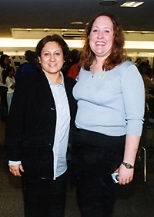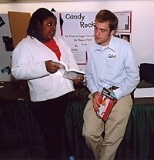Twenty-one Boston eighth-graders teamed up with 20 MIT student mentors on eight Saturdays this fall in the Science Projects at MIT program, culminating in presentations of their experiments and an awards ceremony in the Stratton Student Center last weekend.
Most of the students from the Umana-Barnes Middle School in East Boston and the Rafael Hernandez School in Roxbury are first-generation Americans and new immigrants from Latin America who speak limited English. Many of them speak Spanish. All of them come from minority communities.
At one time or another, many of them (perhaps all) experienced a "eureka" moment during the program.
"They love their mentors and they loved what they were doing," said Jemima Talbot, coordinator of GEAR UP (Gaining Early Awareness and Readiness for Undergraduate Programs) at Umana-Barnes. "Most of the students have approached me privately to let me know that they want to go to MIT. This speaks more about the program than anything else, and I am tremendously grateful."
The MIT Public Service Center (PSC) sponsored the Science Projects program. The coordinator was Annie Kloimwieder, a junior in biology. Twelve of the 20 mentors were freshmen.
"Coordinating 'Science Projects' has been an absolutely wonderful experience for me," said Kloimwieder. "I get to work with kids, which I love to do. The mentors who work with the kids are also incredible. They've done an amazing job working with these students and teaching them about science.
"I have to say though that some of the most amazing people involved in this program are the students' teachers. And what they tell me is even more amazing - that the kids love the program. Some of these kids want to come to MIT now, which I think is the best statement you could make about the program. I feel amazing knowing that I'm a part of something that's actually making a difference."
Talbot, a former Peace Corps volunteer who grew up in Cambridge, Vt., discovered MIT's support programs when she took a group of students to the Edgerton Center for a summer session. She posted signs for the Science Project around the school at the beginning of the semester and quickly had 14 volunteers.
"I've taken students from the Umana-Barnes to many events and without question, your program has been one of the most positive and empowering that I have seen," Talbot said in an e-mail to Assistant Dean Sally Susnowitz, director of the PSC. "Most of these students don't get much of a chance to see life beyond East Boston, and just the experience of meeting racially diverse 'college kids' - people who are both fun and cool and who are interested in academics - has been terrific."
The Umana-Barnes students traveled to and from MIT by bus, chaperoned by Dan Polcaro of the East Boston YMCA. The Hernandez students were driven by teachers and parents.
Myriam Hibbard, a Hernandez science teacher, recruited the students from her class, organized the trips and conveyed her excitement about the program to the students.
"At the beginning, my fear was that they would only attend one or just a few sessions," Hibbard said. "So I tried to motivate them a lot and every Friday I called them at home and said, 'I'll see you in front of the school at 9 a.m.' And every Saturday morning they were waiting for me."
With each succeeding week, the students became more enthusiastic and discussed their experiments on Mondays with classmates who were not in the program. During the trips to and from Cambridge, they talked about music, weekend plans and their science projects - not always in that order.
"They also talked about the mentors and how they helped them achieve a good result," said Hibbard, who came to the United States from Chile in 1989 and worked in the MIT Division of Comparative Medicine from 1995 to 2001. "They said the mentors were 'cool' and 'nice' and 'very smart.'"
Hibbard's oldest daughter, Loreto Ansaldo, a Hernandez graduate, received the S.B. from MIT in 2000. She's now teaching mathematics and social studies at the Roberto Clemente Intermediate School in the Bronx.
The PSC ran a pilot version of the program for eight high school students last fall. One girl from that group won a prize in the 2002 Boston Science Fair competition, competed at the Massachusetts State Science Fair, and won the bronze medal in the national NAACP-ACTSO physics/electronics division with her project from the MIT program. Two other girls were inspired to join the SEED Academy, an engineering preparatory weekend academy run by Nicole Stark and Karl Reid in the MIT School of Engineering in conjunction with the MITE2S program.
Science Projects at MIT developed out of a partnership among the PSC, the Boston Public Schools, TechBoston Academy and MASS-PEP (the Massachusetts Pre-Engineering Program) to help Boston minority teenagers achieve academic success, particularly in math, science and technology, and to develop the ambition to attend college.
Science Projects at MIT: who's who
MENTORS
Freshmen: Asia Price, Brendan Smith, Brian Glidewell, Christine Chiu, Jean Shon, Kuan-Chi Lai, Mohammed Hussein, Shawntel Hines, Thaddeus Stefanov-Wosner, Victoria (Wei-Feng) Lee, Wey-Jiun Lin and Yao-Chung King.
Sophomores: Mandeep Singh, Rupali Avasare and Shauna Mei.
Juniors: Martin Kurtev and Rachel Livingston.
Seniors: Colin Galbraith, Danielle Lawrence and Leslie Lai.
STUDENTS
Hernandez School: Jessica Colon, Angel Gonzalez, Thrinisha Sanders, Erick Luis Carrasquillo, Sabrina Medina, Alexander Aponte and Sonali Del Valle.
Umana-Barnes Middle School: Aretusa Guerra, Bruno Almeida, Anderson Madrid, Ricky Steven Quinonez, Michelly Teofilo de Oliveira, Martha Galdames, Johnathan Allen, Sebastian Mesa, Nereida Santos, Andrea P. Amador, Andres Builes, Johanna Diaz, Ilka Mercado and Walter Ochoa
A version of this article appeared in MIT Tech Talk on November 20, 2002.







